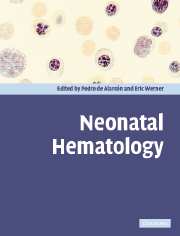Book contents
- Frontmatter
- Contents
- List of contributors
- Foreword
- Preface
- 1 Neonatal hematology: a historical overview
- 2 Disorders of the fetomaternal unit
- 3 Erythropoiesis, red cells, and the approach to anemia
- 4 Anemia of prematurity and indications for erythropoietin therapy
- 5 Hypoplastic anemia
- 6 Hemolytic disease of the fetus and newborn
- 7 Neonatal hemolysis
- 8 Neonatal screening for hemoglobinopathies
- 9 Polycythemia and hyperviscosity in the newborn
- 10 Newborn platelet disorders
- 11 Neutrophil function and disorders of neutrophils in the newborn
- 12 Immunodeficiency diseases of the neonate
- 13 Hemostatic abnormalities
- 14 Transfusion practices
- 15 Umbilical-cord stem-cell transplantation
- 16 Neonatal oncology
- 17 Normal values and laboratory methods
- Index
- References
12 - Immunodeficiency diseases of the neonate
Published online by Cambridge University Press: 10 August 2009
- Frontmatter
- Contents
- List of contributors
- Foreword
- Preface
- 1 Neonatal hematology: a historical overview
- 2 Disorders of the fetomaternal unit
- 3 Erythropoiesis, red cells, and the approach to anemia
- 4 Anemia of prematurity and indications for erythropoietin therapy
- 5 Hypoplastic anemia
- 6 Hemolytic disease of the fetus and newborn
- 7 Neonatal hemolysis
- 8 Neonatal screening for hemoglobinopathies
- 9 Polycythemia and hyperviscosity in the newborn
- 10 Newborn platelet disorders
- 11 Neutrophil function and disorders of neutrophils in the newborn
- 12 Immunodeficiency diseases of the neonate
- 13 Hemostatic abnormalities
- 14 Transfusion practices
- 15 Umbilical-cord stem-cell transplantation
- 16 Neonatal oncology
- 17 Normal values and laboratory methods
- Index
- References
Summary
Introduction
Significant progress has been made towards the understanding of the clinical implications of the neonatal immune system and its immaturity. With the increasing survival of extremely premature infants, neonatologists and other physicians caring for these patients must be aware of the vulnerability of this select patient population. It is also important for neonatologists and pediatricians to be able to differentiate between immune immaturity and a true primary immunodeficiency that may present during the neonatal period. Failure to identify properly primary immunodeficiency diseases can result in delayed diagnosis and treatment, which can significantly affect the outcome of the disease. This chapter defines the immune immaturity of the neonate and how it impacts susceptibility to neonatal infection. It will describe the specific immune deficiency syndromes that may present during the neonatal period. Finally, the diagnosis and management of neonatal immunodeficiency diseases will be discussed in length in order to provide the reader with the proper approach and management guidelines to care adequately for these individuals.
Immaturity of the neonatal immune system
The immaturity of a neonate's immune response places the neonate at an increased risk for serious infection. An understanding of the development of the neonatal immune system is essential in order to be able to differentiate the clinical manifestations of infection associated with immaturity from those that identify a specific acquired or primary immunodeficiency disease. The focus of this section is to define how the immune immaturity of the neonate impacts susceptibility to infection.
- Type
- Chapter
- Information
- Neonatal Hematology , pp. 280 - 309Publisher: Cambridge University PressPrint publication year: 2005



